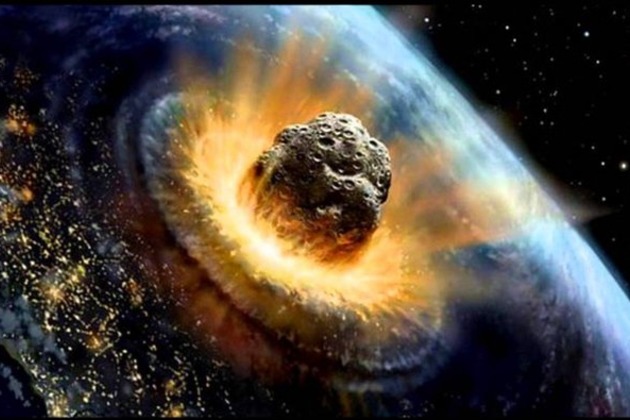ScienceRocks
Democrat all the way!
- Banned
- #1
Neil deGrasse Tyson: Where are the Aliens?
Interesting show on the topic. I really like Neil deGrasse Tyson!
Follow along with the video below to see how to install our site as a web app on your home screen.

Note: This feature currently requires accessing the site using the built-in Safari browser.
The shocking revelations were made by Leroy Chiao, who has spent 230 days in space, spacewalked six times in 15 years and has successfully completed four missions in space as a commander of the International Space Station. Chiao is persuaded by the fact that aliens exist and they may attack us. He doesn’t foresee a bright future for Earthlings. He envisions that if humans and aliens discover each other, they might even destroy us and our beloved planet.
Chiao said that aliens would not like to be found through our world’s scientific methods and if we do, somehow, find them, it wouldn’t be a groundbreaking discovery but a major catastrophe. He wrote on space.com, “The possibility of extraterrestrial life has fascinated humans since our awareness that such a thing could exist, and with the recent discovery of a possibly Earth-like planet around a star in our cosmic backyard, tantalising new questions are being raised about the possibility of finding life elsewhere in the universe." "Moreover," he affixes, "I believe that at some point, life on Earth will die out, either from natural causes, or from our own doing.”

Chiao pointed out, “I believe that life is always starting in some parts of the universe at the same time that it is dying out in others. We don't know about each other, simply because the distances are so vast. We won't easily find evidence of alien life around another star, especially those that are hundreds of millions of light-years away, or more." Mars is probably the planet with life because of the temperature and containment of water, therefore, "The discovery of incontrovertible evidence of past or present life on Mars would prove my theory on alien life. Let's continue to explore Mars, which is in our own 'backyard'," he added.
Chiao isn’t the only one who thinks alien life exists. Previously, Seth Shostak, a senior astronomer at the California-based Search of Extraterrestrial Intelligence Institute, informed the U.S., “At least a half-dozen other worlds (besides Earth) that might have life are in our solar system." “The chances of finding it, I think, are good, and if that happens, it'll happen in the next 20 years, depending on the financing,” Shostak had stated. With conspiracy theorists blaming NASA and the U.S. government for cover ups on alien existence and increased UFO sightings further reiterating the conspiracies - it probably will be only a matter of time before the clash of existence that Chiao warns of might happen.
Former NASA astronaut issues chilling warning claims aliens ready to destroy Earth

1. I want to know if life used to be on Mars.
The areas with less stellar material are typically older and more stable regions, and therefore, the Galactic Habitable Zones. In order to find life out there, perhaps one must look toward the outer edges. This also narrows down our search by many orders of magnitude.
1. I want to know if life used to be on Mars.
The areas with less stellar material are typically older and more stable regions, and therefore, the Galactic Habitable Zones. In order to find life out there, perhaps one must look toward the outer edges. This also narrows down our search by many orders of magnitude.
2. I think tardigrades live in Europa
3. I think there's life on comits.
4. I think the distance between us and anything as smart as us is too far for even them.
5. Consider intelligent life could have searched our corner of the universe 1 million years ago when we were half moneys and they moved on unimpressed.
6. Or they couldn't live here just like we couldn't survive on their planet.
7. And most "smart" animals on other planets might be dolphin smart or elephant smart. They aren't building space ships.
This earth we call home, is not ready to face any unexpected calamity that apparently is coming our way. The threat is two-fold: Aliens and asteroids, both taking aim of earth. On Thursday, U.S. President Barack Obama's Chief Science Advisor prompted that our planet was “not prepared” for an eventual asteroid strike that is deemed catastrophic.
John Holdren, Officer of Science and Technology policy for the White House has broken the culture of silence around the potentiality of a dangerous meteor shower on Earth. He stated that while NASA had made wonderful progress on tracking deadly space rocks, it still had a lot to do. During a discussion at NASA’s Goddard Space Flight Center regarding NASA’s planned Asteroid Redirect Mission, he stated, "We are not fully prepared. But we are on a trajectory to get much more so.” Holdren prompted everyone to take the threat of this potential catastrophe seriously.

The agent of science gave an example of the disastrous meteor that destroyed the Russian city of Chelyabinsk. This meteor injured more than 1,200 people and damaged 7,200 buildings in 2013. Holdren cited the example of the event that has since come to be known as the Tunguska airburst that took place in 1908 and the meteor explosion over the Russian city of Chelyabinsk in February 2013. He pointed out these events definitely proves that we need to take the threat of asteroids seriously. He claimed, "We know that this does happen. Strikes such as what happened in Chelyabinsk are thought to happen once in every hundred years, while Tunguska is regarded as a once in 1,000 years event."
Meanwhile, officials have said that NASA is set to launch an asteroid mission. The mission, ARM mission, costs $1.25 billion and will provide scientists with an insight into massive space rocks. Holdren advised everyone to prepare themselves for “the rare event.” He stated, "If we are going to be as capable a civilisation as our technology allows, we need to be prepared for even those rare events. Because they could do a lot of damage to Earth. This is a hazard that, 65 million years ago, the dinosaurs succumbed to. We have to be smarter than the dinosaurs.”
Earth faces celestial crisis Aliens asteroids black holes threaten Are we prepared
With a diameter of 500 meters, and a reflector spanning the size of 30 football fields, the Aperture Spherical Radio Telescope (FAST) is situated in the southern mountainous province of Guizhou, and is said to far outsize Puerto Rico’s Arecibo Observatory, according to the official Xinhua news agency. The $180 million (1.2 billion yuan) project - which took five years to complete - was constructed with the aim to detect radio signals from stars and galaxies, gravitational waves and hunt for signs of extraterrestrial life, according to researchers. “In theory, if there is civilisation in outer space, the radio signal it sends will be similar to the signal we can receive when a pulsar (spinning neutron star) is approaching us,” Qian Lei, a National Astronomical Observatories of the Chinese Academy of sciences associate researcher, told state broadcaster CCTV.

The telescope was said to have successfully received radio signals from a pulsar 1,351 light-years away from earth during a recent test. FAST follows China’s august quantum satellite launch and that of Tiangong 2 - the country’s second space station - earlier this month. This marks another step in China’s military-run space program that has future plans of sending a mission to Mars and that Beijing considers to be a symbol of its progress.
The construction and launch of FAST saw the relocation of more than 8,000 people living within a five-kilometre radius of the telescope as it requires “radio silence” to perform optimally, according to state media. Other large-scale infrastructure projects in the past have led to the similar relocation of hundreds of thousands of people in China. In August, officials reported that a budget of approximately $269 million from a poverty relief fund and bank loans would be used to compensate villagers that were affected.
We might hear from aliens sooner than we think
Hawking has warned that Earth should be wary about answering alien signals. He has suggested in a recent online short film about the Universe that advanced civilisations that might try to contact us, might attempt to colonise Earth. The chilling warning came in the film, in which Hawking travelled to a planet 16 light years away called Gliese 832c, which he believes could be home to intelligent life. Movies and pop culture might have painted a very interesting picture of what aliens might look like or ways in which they might communication or just how bizarre human lifestyle could sound to them - Hawking, however, paints a fearsome picture. He says that if we were to come face to face with an advanced civilisation - it could be similar to when the “Native Americans first encountered Christopher Columbus – and that didn't turn out so well.”
In the film titled Stephen Hawking’s Favourite Places, he says, “Gazing at the stars I always imagined there was someone up there looking back. As I grow older I am more convinced than ever that we are not alone. After a lifetime of wondering, I am helping to lead a new global effort to find out. The Breakthrough Listen project will scan the nearest million stars for signs of life, but I know just the place to start looking. One day we might receive a signal from a planet like Gliese 832c, but we should be wary of answering back.” In the movie, he visits the deep super massive black hole, Sagittarius A* in the film and then travels to Gliese 832c which has been defined as a ‘super-Earth’ being at least five times as massive as Earth itself. Hawking narrates that the planet is most Earth-like exoplanet in the universe. He explains that the planet could be the best place for potential extraterrestrial life.
While there, he says, “In recent years, we have found thousands of planets outside our solar system. Some were burning hell caves of fire and lava, while others are solid diamond made of dying stars. But some are like home and incredibly, we found one only 16 light years away right on our doorstep.” He added, “Finding intelligent life would be the single greatest discovery in history - it would force us to change. We would have to give up the idea that we are unique and start acting with more compassion and humility.” International astronomers have pointed out that the exoplanet is in the star Gliese 832c’s 'habitable zone.’ This makes the planet in just the right range of distances that could allow liquid water to exist on a world's surface. In the year 2014, Robert Wittenmyer from the University of New South Wales in Australia along with his team had discovered Gliese 832c.
They reportedly spotted tiny wobbles that the planet's gravity induces in the motion of its host star in data gathered by three separate instruments. Wobbles were noticed in data from the University College London Echelle Spectrograph on the Anglo-Australian Telescope in Australia, the Carnegie Planet Finder Spectrograph on the Magellan II telescope in Chile and the High Accuracy Radial Velocity Planet Searcher (HARPS) spectrograph, which is part of the European Southern Observatory's 11.8-foot (3.6 meters) telescope at the La Silla Observatory in Chile.
Hawking says, “Here a year only lasts 36 days. Its atmosphere could be thick, smothering the surface in super thick fog or worse, it could have a gravity of its nearby sun. One side is always facing the sun, perhaps not a good place for a picnic after all.” He says that “due to the sun’s light, the foliage on the surface is black and purple. This distant world may also have Earth-like temperatures with abundant liquid water and intelligent animals. And where there is water, there is usually life.” Adding, “From Earth we cannot see what lies on 832C, but if intelligent life has evolved here we should be able to hear it. Using the world’s most sensitive radio telescopes what might we hear? Maybe an alien opera or perhaps a phone call home.”
BEWARE!
With all the knowledge available about Gliese 832c and with many nations making advances in space science - the possibility of making contact with intelligent alien life forms has only increased. Hawking, however, thinks we’re playing a dangerous game by trying to contact them. He believes that “if aliens discovered Earth, they are likely to want to conquer and colonise our planet.” Speaking in an interview, he said, “If aliens visit us, the outcome could be much like when Columbus landed in America, which didn't turn out well for the Native Americans.”
Beware of answering alien signals they could attempt to colonise Earth
if aliens who survive to go to space are anything like humans
then theres permanent war in the milkyway and propably everyone got bombed back to the stoneage around here,about 50 000 years ago
maybe suns don t go Nova or supernova on their own maybe people kill suns
maybe its very difficult to survive
First of all, too many unknowns in the Drake Equation. Second, the assumption that life will arise only on earth like planets is, in my opinion, an unsupportable assumption. Anywhere there are organic compounds, and energy within certain ranges, I think there is the possibility of life, and life not as we know it. For instance, in our own system, the clouds of Jupiter.It is astonishing to me what people here find interesting and do not.
The Drake Equation was brought up in the discussion, and no one finds a discussion of the values used in that equation to be food for thought?
I dont get it.
Genetic engineering, nano-tech, breakthroughs in the understanding of the brain. Yes, it is possible that we can achieve both peace and an indefinite lifespan. In fact, the latter makes the former more imperative. What is the use in achieving an indefinite lifespan, only to lose that life in a foolish war.if aliens who survive to go to space are anything like humans
then theres permanent war in the milkyway and propably everyone got bombed back to the stoneage around here,about 50 000 years ago
maybe suns don t go Nova or supernova on their own maybe people kill suns
maybe its very difficult to survive
I think a prerequisite for any advanced intelligent life to achieve interstellar travel and commerce is a militant passivity; that is an oxymoron, I know, but we developed nukes just 70 some odd years ago, and there are probably worse weapons that can destroy humanity entirely that may be only a couple of decades away. We are, for example, on the cusp of genetic engineering becoming a household utility; how do we stop permanently aggressive and suicidal cultures from developing pandemic diseases and spreading them around the globe?
We have to insist on passive cultures that cherish peace and a common brotherhood of mankind or we will not survive the next century.
In essence, we have to use nonviolent means to suppress and eliminate violent expansive cultures that accept the concept of conquest of other cultures as a viable means to improve their own lives and economies. This REQUIRES the rejection of Multi-culturalism that we have today, that pretends that the culture of Russia today is no better than that of the ancient Aztecs that sacrificed 10,000 human lives per day at one point. Not all cultures are equal and violent predatory cultures must be viewed as intolerable, and soon.
If any alien life is in fact out there, and I believe that there most certainly is, then it is PEACEFUL and not bent on the conquest of every wet rock they come across in the universe.
Genetic engineering, nano-tech, breakthroughs in the understanding of the brain. Yes, it is possible that we can achieve both peace and an indefinite lifespan. In fact, the latter makes the former more imperative. What is the use in achieving an indefinite lifespan, only to lose that life in a foolish war.if aliens who survive to go to space are anything like humans
then theres permanent war in the milkyway and propably everyone got bombed back to the stoneage around here,about 50 000 years ago
maybe suns don t go Nova or supernova on their own maybe people kill suns
maybe its very difficult to survive
I think a prerequisite for any advanced intelligent life to achieve interstellar travel and commerce is a militant passivity; that is an oxymoron, I know, but we developed nukes just 70 some odd years ago, and there are probably worse weapons that can destroy humanity entirely that may be only a couple of decades away. We are, for example, on the cusp of genetic engineering becoming a household utility; how do we stop permanently aggressive and suicidal cultures from developing pandemic diseases and spreading them around the globe?
We have to insist on passive cultures that cherish peace and a common brotherhood of mankind or we will not survive the next century.
In essence, we have to use nonviolent means to suppress and eliminate violent expansive cultures that accept the concept of conquest of other cultures as a viable means to improve their own lives and economies. This REQUIRES the rejection of Multi-culturalism that we have today, that pretends that the culture of Russia today is no better than that of the ancient Aztecs that sacrificed 10,000 human lives per day at one point. Not all cultures are equal and violent predatory cultures must be viewed as intolerable, and soon.
If any alien life is in fact out there, and I believe that there most certainly is, then it is PEACEFUL and not bent on the conquest of every wet rock they come across in the universe.
But there will be many that fight the whole idea. For it requires some very basic changes in outlook, and what we value.
if aliens who survive to go to space are anything like humans
then theres permanent war in the milkyway and propably everyone got bombed back to the stoneage around here,about 50 000 years ago
maybe suns don t go Nova or supernova on their own maybe people kill suns
maybe its very difficult to survive
